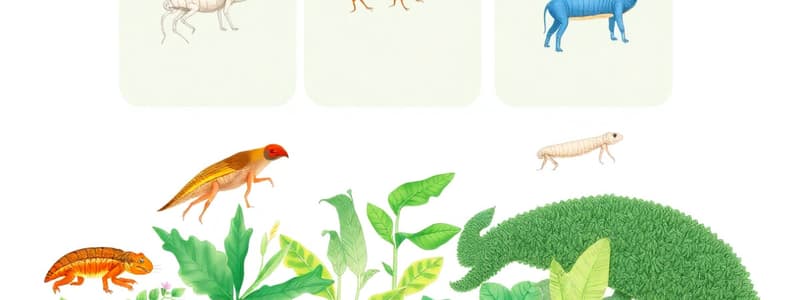Podcast
Questions and Answers
Which process involves the breakdown of nutrient molecules to release energy?
Which process involves the breakdown of nutrient molecules to release energy?
- Reproduction
- Respiration (correct)
- Sensitivity
- Excretion
In the context of living organisms, what does growth refer to?
In the context of living organisms, what does growth refer to?
- A permanent increase in size (correct)
- An increase in movement speed
- An increase in sensitivity to the environment
- A temporary change in size
What is the primary role of excretion in living organisms?
What is the primary role of excretion in living organisms?
- To remove waste products from metabolism (correct)
- To detect changes in the environment
- To reproduce and create offspring
- To obtain energy from food
Which statement about classification systems is true?
Which statement about classification systems is true?
What do animals primarily require for nutrition?
What do animals primarily require for nutrition?
What defines a species in the context of classification?
What defines a species in the context of classification?
How do plants obtain their nutritional requirements?
How do plants obtain their nutritional requirements?
Which characteristic allows living organisms to respond to changes in their environment?
Which characteristic allows living organisms to respond to changes in their environment?
What is the primary advantage of using DNA sequencing over traditional morphological categorization?
What is the primary advantage of using DNA sequencing over traditional morphological categorization?
Which of the following is NOT a characteristic that differentiates plant cells from animal cells?
Which of the following is NOT a characteristic that differentiates plant cells from animal cells?
In the classification of organisms, what distinguishes vertebrates from arthropods?
In the classification of organisms, what distinguishes vertebrates from arthropods?
Which groups are included within the plant kingdom classification?
Which groups are included within the plant kingdom classification?
How does DNA code relate to proteins in the context of evolutionary studies?
How does DNA code relate to proteins in the context of evolutionary studies?
Which group does NOT fall under the arthropod category?
Which group does NOT fall under the arthropod category?
What distinguishes dicotyledons from monocotyledons in flowering plants?
What distinguishes dicotyledons from monocotyledons in flowering plants?
Which characteristic of the cytoplasm is essential for cellular reactions?
Which characteristic of the cytoplasm is essential for cellular reactions?
Flashcards
Living organisms
Living organisms
Organisms that show the 7 characteristics: movement, respiration, sensitivity, growth, reproduction, excretion, and nutrition.
Movement
Movement
Ability of a living organism to move itself, or parts of itself, to find food, escape predators or catch sunlight.
Respiration
Respiration
Chemical reactions in cells that break down nutrients for energy.
Sensitivity
Sensitivity
Signup and view all the flashcards
Growth
Growth
Signup and view all the flashcards
Reproduction
Reproduction
Signup and view all the flashcards
Excretion
Excretion
Signup and view all the flashcards
Nutrition
Nutrition
Signup and view all the flashcards
Species
Species
Signup and view all the flashcards
Binomial naming system
Binomial naming system
Signup and view all the flashcards
Classification
Classification
Signup and view all the flashcards
Organism Classification
Organism Classification
Signup and view all the flashcards
Morphology
Morphology
Signup and view all the flashcards
Anatomy
Anatomy
Signup and view all the flashcards
DNA Sequencing
DNA Sequencing
Signup and view all the flashcards
Evolutionary Relationships
Evolutionary Relationships
Signup and view all the flashcards
Five Kingdoms
Five Kingdoms
Signup and view all the flashcards
Animal Cells
Animal Cells
Signup and view all the flashcards
Plant Cells
Plant Cells
Signup and view all the flashcards
Vertebrates
Vertebrates
Signup and view all the flashcards
Arthropods
Arthropods
Signup and view all the flashcards
Study Notes
Characteristics of Living Organisms
- All living organisms exhibit movement, either of the whole organism or parts.
- Respiration involves chemical reactions releasing energy from nutrients.
- Organisms exhibit sensitivity, responding to internal or external changes.
- Growth involves a permanent increase in size (dry mass, cell size, or number).
- Reproduction creates new organisms of the same kind.
- Excretion removes waste products (toxic materials, excess substances, carbon dioxide).
- Organisms need nutrition to develop and repair. Needs differ between animals and plants/
Classification Systems
- Classification groups species based on shared features.
- Species can reproduce and produce fertile offspring.
- Organisms are named using the binomial system (genus and species).
- Organisms are classified by evolutionary relationships, determined by physical characteristics or DNA sequences.
- Traditional classification used morphology and anatomy. Modern methods include DNA sequencing.
Features of Organisms
- Organisms are categorized into five kingdoms: Animalia, Plantae, Fungi, Prokaryota, and Protoctista.
- Cell features (e.g., cell wall, chlorophyll) differentiate kingdoms.
- Animal cells lack cell walls and chlorophyll.
- Plant cells do contain cell walls and chlorophyll.
- Eukaryotic cells have a membrane-bound nucleus, whereas prokaryotic cells do not.
Classification of Animals
- Vertebrates possess a backbone (mammals, birds, reptiles, amphibians, fish).
- Arthropods lack a backbone. Identified by exoskeletons and segmented bodies (myriapods, insects, arachnids, crustaceans).
Plant Classification
- Plants are divided into flowering and non-flowering groups.
- Flowering plants are further categorized into dicots and monocots.
- Dicots and monocots are identified by their leaves.
- Non-flowering plants (like ferns) reproduce via spores.
Viruses
- Viruses are not considered living organisms.
- They lack the ability to carry out the life processes of living things.
- Viruses consist of genetic material enclosed in a protein coat.
Studying That Suits You
Use AI to generate personalized quizzes and flashcards to suit your learning preferences.




